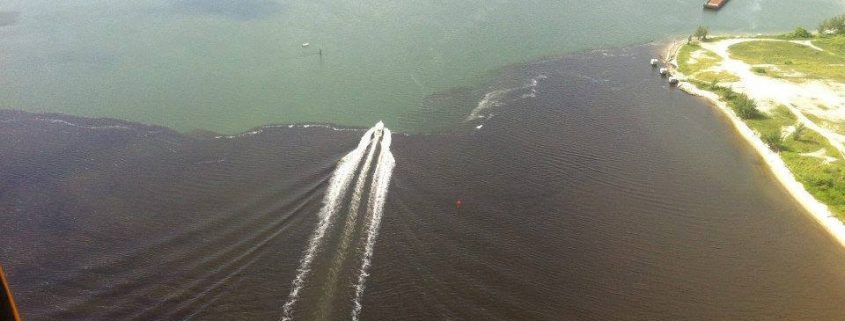Florida Marine Life Dying From Pollution
by Chelsea Olson, RJD Intern
While much of the attention as of lately has been on Japan and the Fukushima radiation’s potential effects, a source of serious concern has been spreading in our own backyards. Many of Florida’s waterways are becoming increasingly polluted and, in turn, affecting local marine life, the ocean and our ecosystem. This also directly affects humans who rely on safe ocean water to fish from and swim in.
Due to the heavy rainfall this past summer, Lake Okeechobee has needed to release excess water into surrounding canals and estuaries to prevent a breach of the lake’s levees. Lake Okeechobee’s water lowers the salinity, carries dirt that makes the water murky, and carries high levels of two pollutants that bring major problems: nitrogen and phosphorus (Allen). Taylor Creek in Fort Pierce, St. Lucie River and Indian River Lagoon are all receiving this polluted overflow (McCorquodale).
In Indian River Lagoon alone, which has now been deemed a “killing zone” and “mass murder mystery,” there have been 46 dolphins, 111 manatees, 300 pelicans and 47,000 acres of sea grass beds killed off (McCorquodale). Much of this comes from large, toxic algae blooms that have formed due to the abnormal water conditions and pollutants. These blooms have destroyed sea grass beds, which comprise a majority of a manatee’s diet. Now they’re eating a red seaweed macro algae that’s become toxic with the lagoon’s unnatural growing conditions (Allen).
But this isn’t exactly a recent phenomenon. A yeast-like infection called lobomycosis, previously known to be an exclusively human disease, was first documented on a bottlenose dolphin in southern Brazil in 1993. This female adult was found in a river estuary, which has a mix of fresh and salt water conditions (BDFS Brazil). In 2006, a study was conducted to determine if there was a strong presence of lobomycosis in dolphins at the Indian River Lagoon. It was concluded that “lobomycosis may be occurring in epidemic proportions among dolphins in the Indian River Lagoon (Reif).” Lobomycosis was found in dolphins captured in the southern part of the lagoon, where freshwater intrusion was found, along with lower salinity levels, suggesting that “exposure to environmental stressors may be contributing to the high prevalence of the disease (Reif).”
While marine life deaths rise and toxic algae continues to grow, local Florida politicians have declared a crisis and are seeking the help of the government for solutions. It appears to be a two-fold process, however, both of which won’t help with the short-term crisis. Scientists point to the need of ceasing drainage from Lake Okeechobee into the Indian River Lagoon altogether and redirecting its natural flow to the south through the Everglades. There’s also the larger and more difficult issue of septic systems still being in place among these counties on the lagoon. “Over 1 million kilograms of nitrogen a year are going toward the Indian River Lagoon from septic tanks alone,” says Brian Lapointe, a research professor at Harbor Branch who’s been working on the lagoon’s crises for 40 years (Allen).
One can only hope that politicians, marine researchers and communities can all work together toward a long-term solution. This region badly needs to restore its ecosystem so that residents can once again partake in fishing, swimming and the everyday practices of a coastal town.
REFERENCES
Allen, Greg. “With Murky Water And Manatee Deaths, Lagoon Languishes.” NPR. NPR, 26 Sept. 2013. Web. 16 Oct. 2013.
BDFS Brazil. “First Case of Lobomycosis in a Bottlenose Dolphin from Southern Brazil.” Marine Mammal Science 9.3 (1993): 329-31. Google Scholar. Web. 22 Oct. 2013.
Indian River Lagoon, Florida. 2006. Photograph. US Fish and Wildlife Service, Florida. Wikimedia Commons. Wikipedia, 6 Apr. 2006. Web. 22 Oct. 2013.
McCorquodale, Amanda. “Devastating Photos Of Florida Pollution Will Fill You With Rage.” The Huffington Post. TheHuffingtonPost.com, 02 Oct. 2013. Web. 16 Oct. 2013.
Reif, John S., DVM. “Lobomycosis in Atlantic Bottlenose Dolphins from the Indian River Lagoon, Florida.” Journal of the American Veterinary Medical Association 228.1 (2006): 104-08. AVMA. American Veterinary Medical Association, 15 July 2008. Web. 16 Oct. 2013.






Leave a Reply
Want to join the discussion?Feel free to contribute!